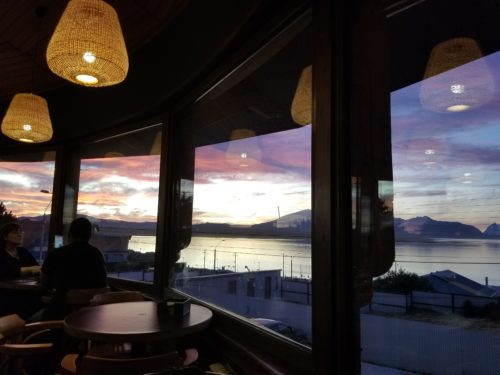The Patagonia region is home to numerous national parks throughout both Chile and Argentia. At 150 thousand guests each year, the most visited of them all is Torres del Paine. Compare that number to the 500k average yearly visitors at Peru’s Machu Picchu or California’s Yosemite National Park with nearly 5 million people/year, and even on the busiest trails in Torres del Paine you will still find space to contemplate the quiet beauty of nature.
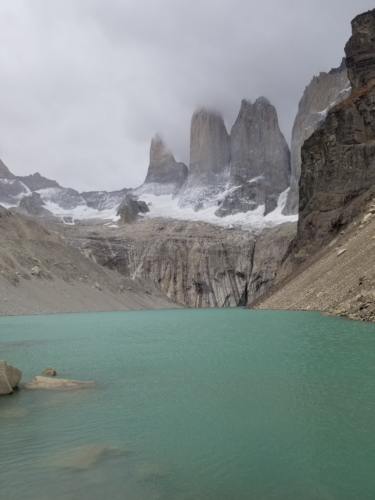
Torres del Paine translates to “Blue Towers”, which comes from the huge, blue glacier lakes that surround the area as well as the famous rock pillars (above) that look like towers jutting up from the rocks below.
In February of 2020, my friend Dan and I took a week-long backpacking trip along the “W” traverse of the park. There are two main routes that visitors hike - the “W” trek, which is about 46 miles long, and the “O” circuit, which is about 68 miles. Both routes cover the same quintessential view points, however the “O” adds an extension around the backside of the park that makes the trip into a loop instead of a traverse.
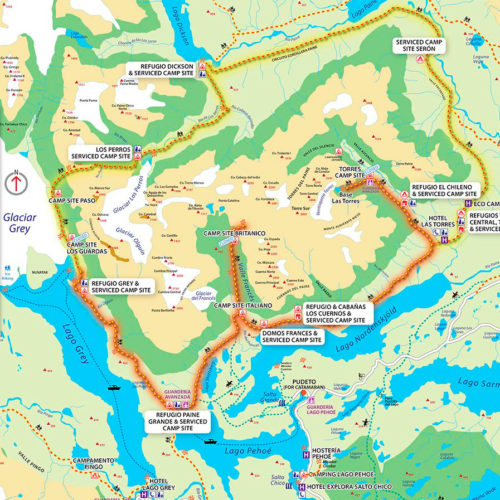
Both the W and the O are named after the shape of the trails themselves. As you can see, the O includes the W in it. Map from ExperienceChile
If you have the time, the “O” really looks like it would be an incredible addition to the hike. In our planning, we had hoped to be able to complete the full loop, but due to the unfortunate reality of limited vacation time we only had a week including travel for this adventure. Thus we chose the “W” and took on the trail with absolutely no regrets.
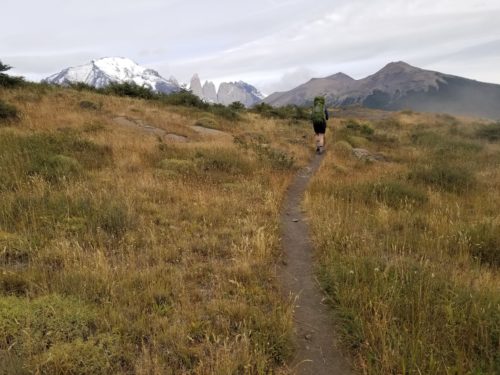
Getting There
Making our way from the northeastern United States all the way to what is just about the southernmost point in the world outside of Antarctica was an adventure of its own. Part of our choice in choosing Torres del Paine was that it has some of the best infrastructure for getting in and out of the park compared to other areas in the Patagonia region.
Our itinerary for getting there was a flight from Boston to New York followed by an 8 hour layover, and then an overnight flight from New York into Santiago, Chile. From there we would have 2 hours to get through customs, recheck our luggage, and then take another 4 hour flight to Punta Arenas. At that point, we would get on a bus for 3 more hours to Puerto Natales, the closest town to the park. The following morning we would then get up at 5:30 am to get on another bus that would finally get us into the park at 9:30 am.
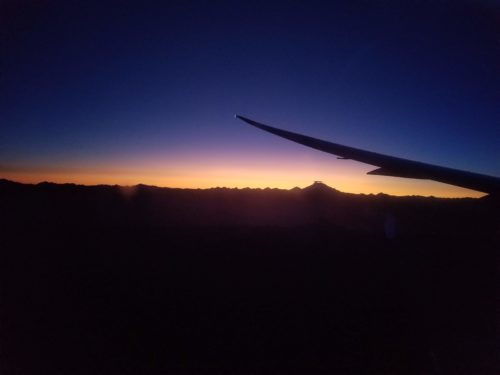
Of course a plan as intricate as that was bound to fail somewhere along the way. It turned out that our connecting flight from Santiago to Punta Arenas was completely incorrect from the one that was sold to us. As in the gates closed before we were even off the first flight! Thankfully, we were able to get on board another one that day, and were also able to get on a later bus ride to Puerto Natales. The biggest impact the mishap had on our trip was that almost all of the grocery stores were closed by the time we got into the town. We had to hobble together whatever camping food we could find which led to an unfortunate week of eating mostly unsalted beans and rice!
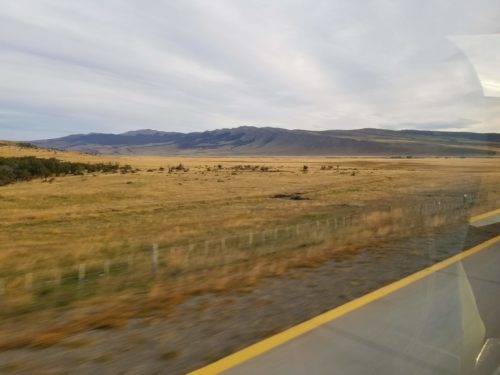
The bus rides themselves were a beautiful part of the trip in their own right.
Day 1: The Base of Las Torres
After 3 hours on the bus (and 2 days of travel leading up to that point), we finally reached Torres del Paine National Park. We had the option of taking the bus for another 30 minutes to reach the start of the “W”, or we could walk the 4 mile trail that paralleled the dirt road. Anxious to get hiking, we opted to walk the distance without a moment of hesitation.
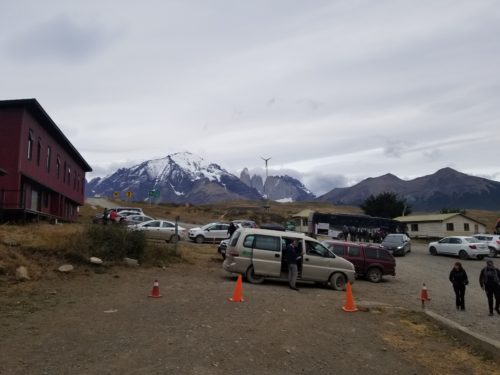
The bus dropoff point. Las Torres rises up in the distance.
Having our feet on the dirt after so much sitting was exhilarating. We walked through open, yellow grasslands as “Las Torres” (The Towers) loomed in the distance. Clouds danced between them and we only hoped it would stay clear enough to see them by the time we reached the base. The entire week pretty much called for rain, but that was part of the adventure of Patagonia. Few people go there without half their time spent in inclement weather.
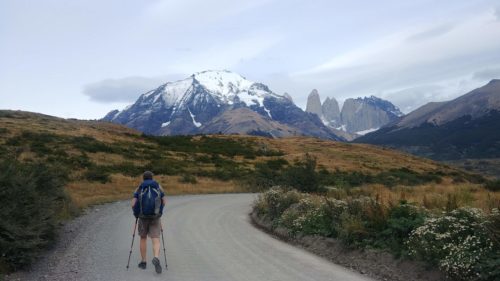
Four miles in and we finally reached the “start” of the park. Had we taken the bus in, this would have been where it dropped us off. There was a small store selling highly priced snacks and alcohol. Something we took note of for later. We pitched our tents in a windy field, finding the few spots left that had some semblance of tree cover. The nights in Patagonia could see gusts of up to 60 mph. Hoping our tents were secured enough for the day, we packed a few snacks and some water and headed off on our main hike of the day - a 10 mile out-and-back to the base of Las Torres.
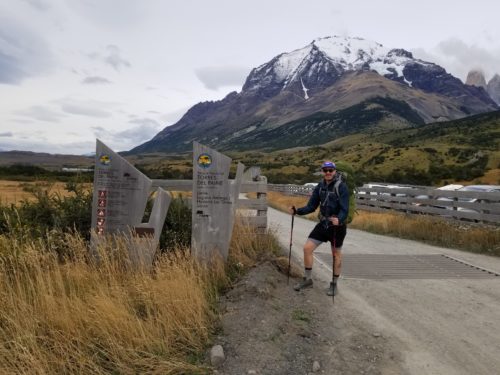
The trail followed a steady but manageable incline as it rose up from the grasslands and into the mountains. It wasn’t long before we entered some beautiful forests - valleys of green built by the natural flow of precipitation captured by the mountains. Back and forth we meandered through trees and open ridgelines, constantly being surprised by what was around the corner.
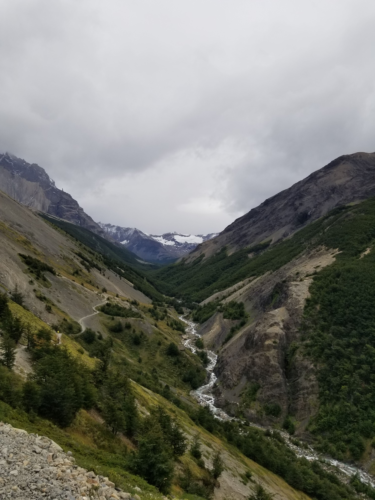
As we closed in on our destination, a dull mist of rain began to fill the air. The path fully broke out of the forest as the flattened treadway turned into a steep rock scramble. With every step closer to the top, the crowds also seemed to increase.
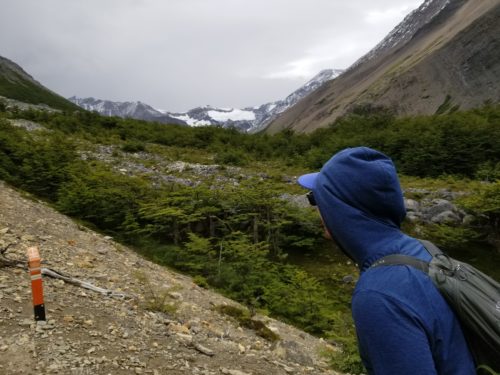
There had been a modest amount of people around us all day, but now that Las Torres were just around the corner the group-per-minute ratio seemed to double, then triple, then quadruple. The wind and mist was picking up too, and the clouds were becoming fuller and darker.
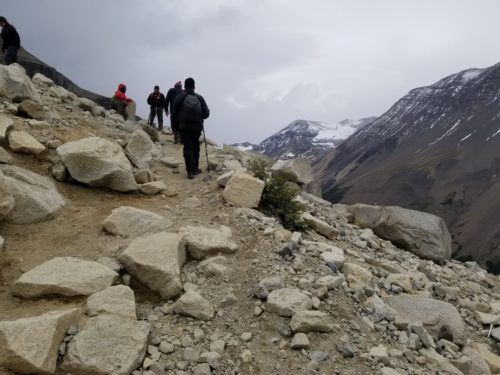
We made it to the top just as powerful, cold wind gusts forced us to throw on all the extra layers we had in our packs. The weather had held out just long enough for us to reach the base of Las Torres, the epic viewpoint we had been seeking all day. It wasn’t long before the wind and the rain picked up and we began our descent back to the campsite. Within 30 minutes, Las Torres was completely socked-in and we were passing signs setup from the rangers that people were no longer allowed to hike up to the base due to the weather. Good luck indeed!

That evening it rained, and rained, and rained. There was a small, sheltered area with picnic tables for people to cook in, but those who had gotten there first did not seem keen on sharing or showing much urgency in letting others have a turn. We found a spot under a big tree that kept us relatively dry and we chatted with a friendly couple from South Dakota while we ate our unsalted lentils and rice.
After dinner it was straight to bed. There isn’t much to do when it’s pouring 45° rain outside and there is no inside to speak of. Once I was cozy in my sleeping bag, I flipped on my headlamp and went to read the book I brought with me as the pitter patter on the tent soothed me closer to sleep. It was then that I realized there was some dampness underneath my sleeping pad. Feeling around with my hand I found that it wasn’t just a little bit of moisture from the rain, but a straight up puddle of water pooling inside of my tent!
I quickly threw everything inside my tent back into my backpack. It was now a relentless downpour outside with no sign of slowing. As I moved about I realized that the ground below had become saturated and I was literally camping in a puddle. The tent that had been my home for 5 straight months along the Pacific Crest Trail must have developed some tiny holes - too small for the eye to notice, too small for even water to typically come through, but enough that camping on a literal pool of water was causing my entire sleep space to flood.
Frantically, I disassembled my tent. The field we were camping in had filled up with hikers over the day and there were almost no viable spots to safely relocate my leaking shelter. After running around for 15 minutes in the rain, I found a raised wooden platform, not the easiest place to set up a tent that is designed around being staked directly into the ground. Eventually I was able to wrap the guy lines around the wood slats and get my tent back up in working order. The next hour was spent drying the interior of my tent with mine and Dan’s mini camping towels. I slept on edge the whole night, scared I was going to wake up soaking wet in 40° temperatures.
Day 2: Campo Italiano
The next morning it was sunny and windy. We had a leisurely start to the day, taking our time to enjoy an oatmeal breakfast as our saturated gear dried. Caracaras, huge birds of prey indigenous to the area, patrolled the campground looking for scraps left by the hikers who had already departed for the day.

Enjoying breakfast under the same tree we cooked dinner under the night before
Our second day of the trek was to be the tamest in terms of the terrain. It was a relatively flat walk that followed a coastal ridgeline overlooking a massive glacier lake on one side and the edge of the mountain range on the other. With Las Torres behind us, the most photographed and well known sight of the park was now in our past. The rest of the trip was set to be a total surprise.
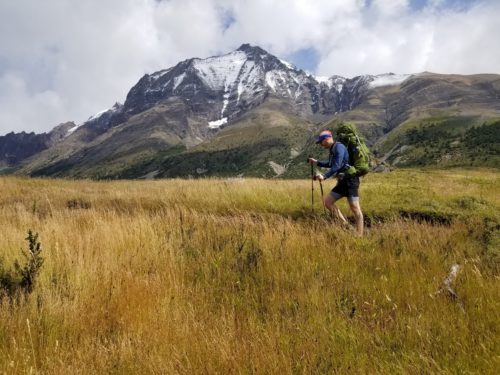
We spent a wonderfully pleasant day tromping through open grasslands, over rocky cliffs, and through pine forests. The massive glacier lake always stayed within our sights. Its color was a thick, turquoise blue. Paired with the yellow grass lands, dark green trees, and gray mountains with glistening snow-capped peaks, it was one of the most colorful environments I had ever been in. At one point the trail even took us down to a black sand beach as the turquoise waves crashed into the shore.
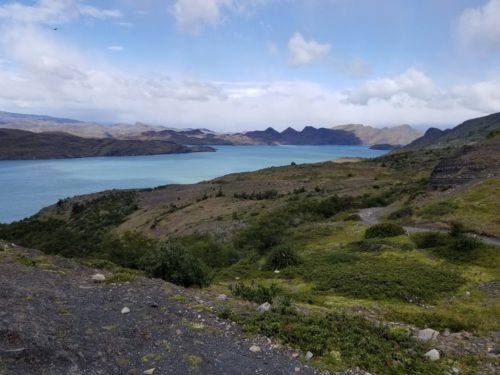
There were some periods of rain, but for the most part we were pretty lucky in the weather we were dealt that day. It was later than expected when we finally made it into our campground, hungry and ready to cook dinner. The tent sites were all in a protected forest, something we are glad to discover as the forecasts were calling for more wind and rain overnight.
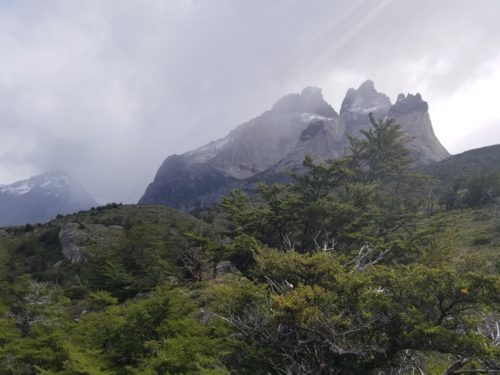
Despite my hope for a dryer night of sleep, it was only an hour or so after retreating into my tent for the night that the downpour started. The water was coming down so fast that the ground below me began to turn into a puddle within minutes. As my tent started to flood, I gave myself a few seconds to quietly curse the powers that be before moving into action mode.
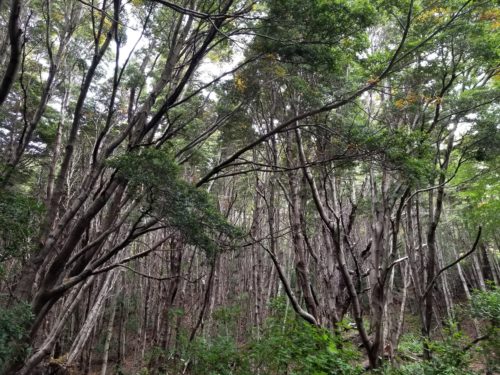
A dense forest covering the campsite.
I once again started packing all of my gear back into my pack. However as I was drying off the interior of the tent, I noticed something was different this time. While the night before I had been camping on a grassy field, the ground of this campsite was 100% mud. With that I started to see small brown spots appearing on the inside of my tent. I quickly realized each spot was one of the small holes that were too small to see but big enough to let the water in.
I grabbed my headlamp, repair tape, and swiss army knife as I proceeded to spend the next hour finding the brown spots and taping them shut. By the time I finished, I had patched 24 separate holes and my tent seemed to be staying dry at that point. The rain had also eased up by then, and I was able to head back to sleep confident that dryer nights were ahead of me.
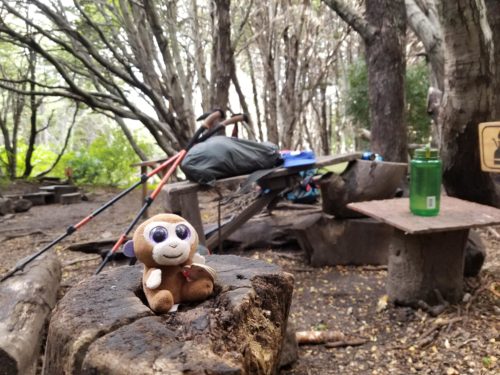
Day 3: Mirador Francés
After another oatmeal breakfast, we were off to a foggy start on our third day of the trek. We were heading up to what was supposed to be some of the most epic views of the whole trip, but as of 10am we still couldn’t see 100 feet in front of us. We left our tents and extra gear behind as we would be heading back the same way before making our way to our next and final campsite later that day.
On the way up we passed a handful of hikers who had camped out near us and had clearly gotten an earlier start as they were already headed back down. To their disappointment, they had remained in the fog the entire morning, not even getting the slightest glimpse of the mountains we sought. We hoped we would be more fortunate.
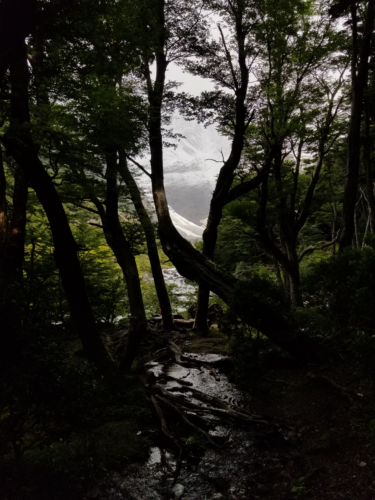
Peering at the mountains through the trees and the morning fog.
By the time we reached the halfway point, and the first of the two viewpoints, a little bit of luck seemed to come our way. The fog did not lift, but it did break enough that the distant formations of rock and ice became partially visible. As we continued further, the break in the clouds revealed a magnificent rainbow like an ode to good luck that the weather might cooperate for us once again.
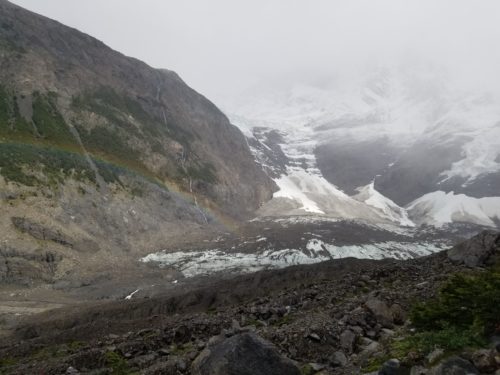
By the time we reached the top, we had been hit with every kind of weather you can imagine. Sunshine, fog, rain, blistering wind gusts, and even a spout of hail. It was all worth it though, because right as we reached that viewpoint the clouds separated and exposed an incredible mountain range circling all around us.
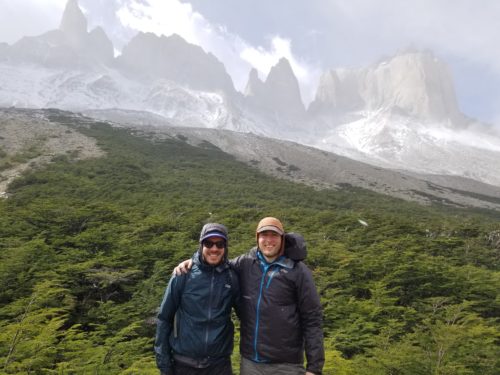
For the full hike back to the campsite the sky remained clear. We routinely had to stop and turn around so that we could take in the sights we missed in the fog on the way up.
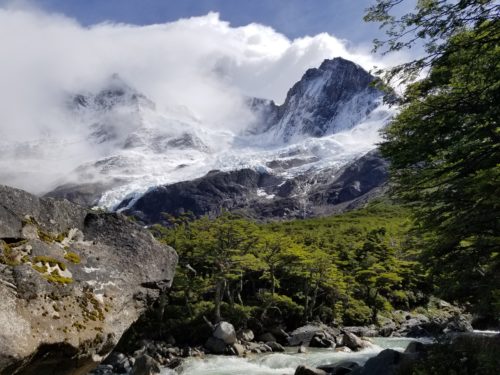
After we passed through the campground and picked up our tents and extra gear, we were off to our next stop where we would spend the last two nights of our trip. We descended down from the mountains and back into the vibrant grasslands with glacier lakes paralleling the trail once more.
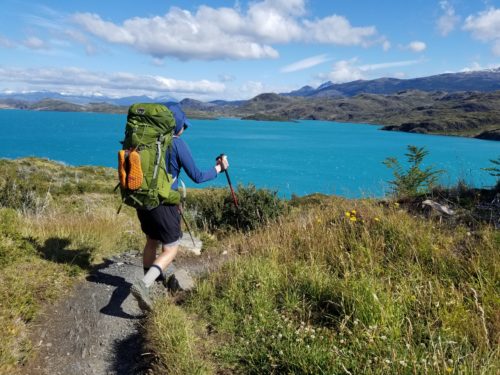
That final campground could be seen in the distance by the time we were a mile away. Unfortunately it looked to be the worst site of the whole trip. At the front of it sat a huge lodge where those who did not wish to camp could pay for a bed and enjoy hot meals in a dining room. The rest of us tenting out were left to a wide open field behind the hotel. A barren space broken up only by the occasional bush. The worst of it was the fact that dozens of other campers had already set up their tents, turning the field into a tent city, each one with only 10 feet between them and their neighbor.

Day 4: Grey Glacier
Despite the lack of solitude, it was the best night of sleep so far. No rain, no wind, just the quiet sound of the breeze as the stars shined over the vast skyline. Dan put it best, he described the nights at that last campsite like feeling “Patagonia breathing.”
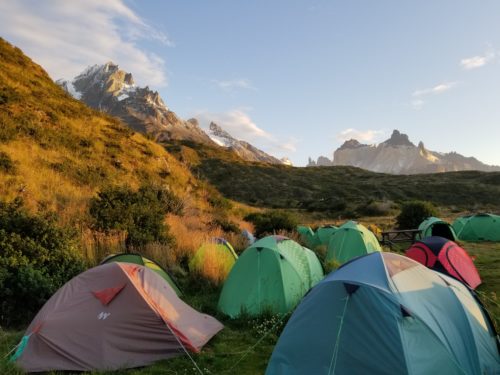
A calm sunset over the campground
The fourth day of our trek was also to be the last day of hiking. We had one more night of camping out, but day 5 would see us packing our bags to begin the return journey. The huge mountains and vast grasslands of the past three days made way for rolling hills and small canyons as we set off on a trail that continued to surprise us around every turn.
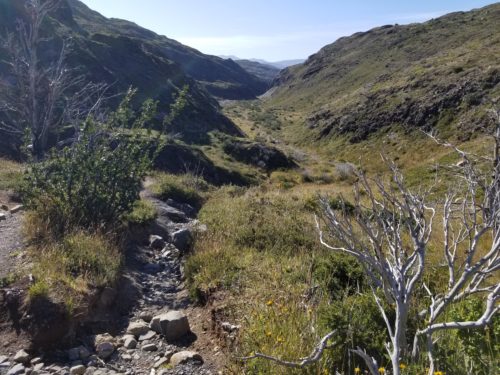
The environment was drier than what we encountered in the other areas of the park. Forests were sparser and the hills were covered in chaparral bushes. It was also the first full day of sunshine of our entire trip. Our over-enthusiasm to finally hike in t-shirts and shorts would come back to bite us when the sting of the sunburns would hit us later that afternoon.
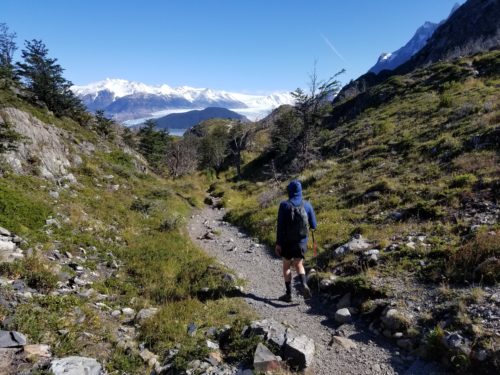
We paralleled another massive glacier-fed lake most of the day. Unlike the turquoise blue lake we followed on previous days, this one was colored a deep gray. Our destination was the massive glacier feeding this lake, which was named, you guessed it, Grey Glacier.
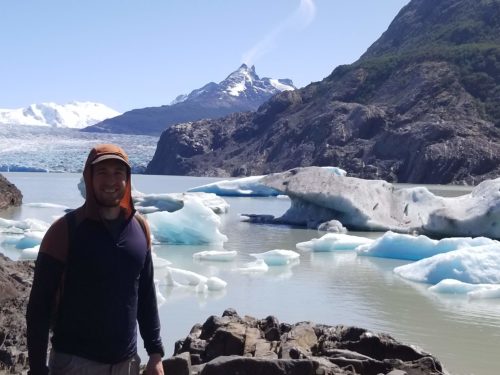
It wasn’t until we arrived at the viewpoint that we truly understood how huge this glacier was. The ice fields stretched from mountain to mountain and reached out into the horizon as far as the eye could see. Icebergs floated by as we relaxed in the sun, taking in all of the beauty.
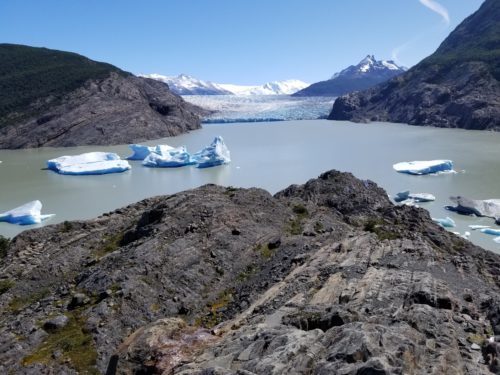
Going Home
That night we celebrated the successful completion of our W Traverse. While the hotel looming over our campsite wasn’t the most sightly, it did offer the benefit of beer for sale.
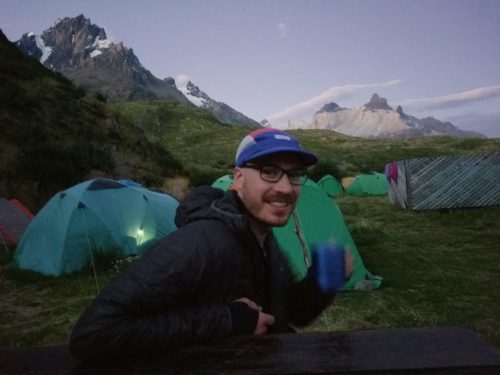
As the sun set, the crystal clear sky showed the stars with prominence and even the milky way was visible in all its glory. We gazed at the night while we reminisced about the trip before heading off to our last night in the Patagonian wilderness.
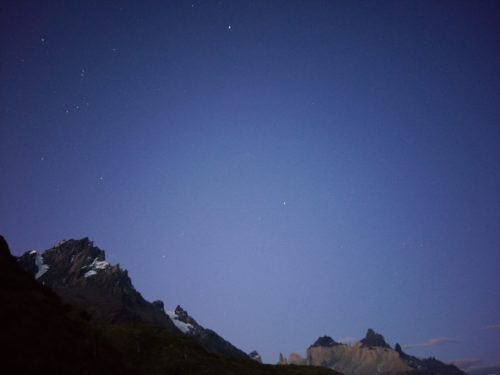
The next morning we took a catamaran over one of the glacier lakes back to where the bus could pick us up. Even the travel was a part of the journey, as we sped by the mountains we had just become so familiar with.
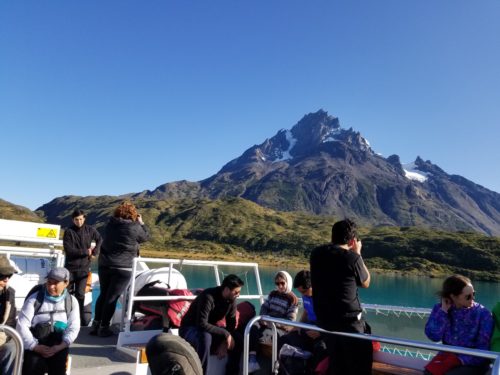
Between naps on the bus ride back to town we saw herds of guanacos, flocks of rheas, and dozens of flamingos. That night we grabbed some drinks at a bar overlooking the sunset behind the mountains and the ocean of southern Chile.
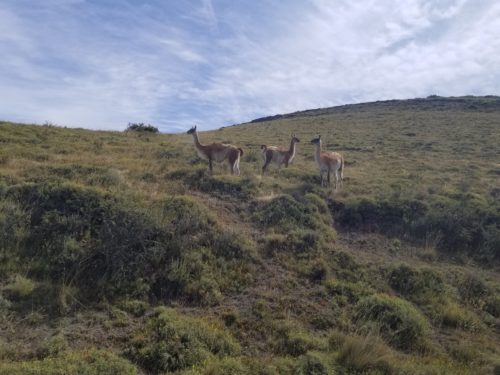
The trip back to the states was relatively smooth. We had the same issue in our New York to Boston transfer as we did on the way down - the tickets sold to us were completely different than what was actually operating. They quickly put us on the next flight and we were back home, already yearning for the next adventure.
